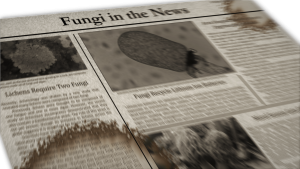#008: “A Glow in the Dark”
Literature Connection: “A Glow in the Dark” from Gary Paulsen’s Woodsong [text here]. I remember reading this short story for an English class in grade school, probably sometime in October. It was only after re-reading this story for this post that I realized how much of the story had stuck with me over the past 7 to 11 years. Maybe now I know I found it so compelling. We were most likely learning about suspense at the time, which is why I decided to use this story for the Fungus Fact Friday post before Halloween. After reading this story and my explanation, you should never again question whether or not fungi can be scary.
While a decent story to introduce students to the concepts of suspense and surprise endings, the story is scientifically lacking. Phosphorous is relatively rare in soil and is very difficult for plants to extract, so how could it randomly become concentrated in a dead stump? What Paulsen is actually describing is an example of “foxfire.” Foxfire refers to the glow produced by bioluminescent fungi. These fungi produce light using the same chemical reactions that fireflies use. If you read last week’s FFF post, you are already aware that certain fungi, such as Omphalotus illudens, produce mushrooms that glow. However, there are also fungi which produce glowing mycelia. Since the mycelium will grow throughout the wood it is decomposing, it can cause the entire piece of wood to glow. Just like in the story this glow can be surprisingly bright, particularly when there are no other lights around. It is this mysterious glow which emanates from the very wood itself that has captured the imagination of many a late-night forest explorer—such as Gary Paulsen.
Paulsen is certainly not the first to write about foxfire; that distinction belongs to Aristotle, who described the characteristic “cold fire” in the 300s BCE. Since then, the foxfire phenomenon has spawned myths of elves, ghosts, and other fictional forest-dwellers. Have you ever wondered why Tinkerbell is green? It’s probably because bioluminescent fungi give off a greenish glow. For the most part, foxfire’s cultural influence is limited to fairy tales. However, there is one instance during the Revolutionary War in which foxfire was utilized. Bits of foxfire were used in the Turtle, the world’s first combat submarine, to light the points of the barometer and compass so that the Turtle could be piloted at night.*
See Further:
http://warnell.forestry.uga.edu/service/library/index.php3?docID=173
* http://www.history.navy.mil/library/online/sub_turtle.htm (search the text for “fox” to find three references to foxfire)

![#007: Omphalotus illudens, the Jack-O-Lantern Mushroom [Archived]](https://www.fungusfactfriday.com/wp-content/themes/hueman/assets/front/img/thumb-medium-empty.png)





![#011: Characteristics of Kingdom Fungi [Archived]](https://www.fungusfactfriday.com/wp-content/themes/hueman/assets/front/img/thumb-small-empty.png)

